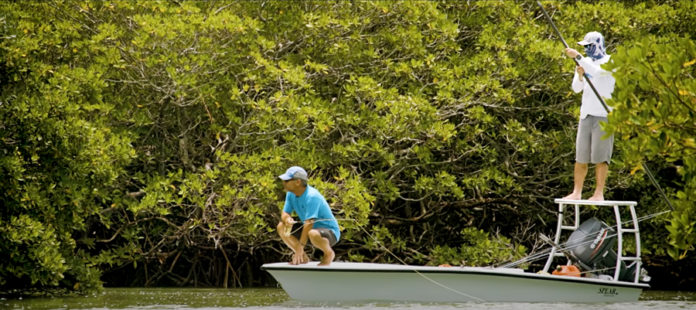Written by: Evan Jones
Fly fishing from a skiff can be challenging, even when you’re doing everything right. Success requires constant coordination between angler and guide, which can be especially difficult if you don’t have much practice. Compounding the challenge is that many of the “rules” of proper skiff etiquette seem to be unwritten, meaning anglers are expected to know them without ever being expressly told what they are.
In order to elucidate the most important rules of skiff etiquette, we asked a few saltwater guides to describe the most common transgressions they experience on a daily basis. Interestingly–but perhaps not surprisingly–each guide gave very similar answers, touching on nearly-identical points, regardless of their location or target clientele. Rather than repeat the same advice over and over again, we compiled their feedback into three main points, supported by quotes from each guide. Keep the following in mind next time you’re on a skiff, and you’ll not only have a more productive day of fishing, but your guide will be happier, too.
1. Respect My Stuff

This one may seem obvious, but it was the first point addressed by every guide. “The most annoying offenses,” says Capt. Michael Leishman of Cajun Adventures in Louisiana, “are the ones that wreck the boat a little bit each day, adding up over time. Things like slamming hatches and deck lids or standing on upholstery.” Capt. Duane Baker, a Florida Keys guide, put it even more succinctly when he said, “A guide’s skiff is his office, so treat it with respect.”
Apparently, a lot of clients wear tennis shoes with marking soles, which leave difficult-to-remove black streaks on the gelcoat, and even cowboy boots, dirtying up the deck and making unnecessary noise. Capt. Conway Bowman in San Diego addressed footwear choice, saying, “Skiffs are not honky-tonk dance floors, so leave the boots and dark-soled shoes at home.”
Don’t leave trash or gear spread out in the boat, cluttering up the limited deck space and causing problems. “I either have to collect the trash myself or instruct them to do so. It’s a big ordeal that can be avoided by not leaving stuff out everywhere,” says Leishman.
2. Balance the Boat
Skiffs tend to be lightweight and finely balanced, meaning even slight shifts in weight distribution can be disruptive. This can be a big problem, especially for guides who frequently use a push pole to move around. Once again, Capt. Baker summarized it best, saying, “In parties of two or more, the non-fisher(s) should stay centered in the skiff.”
But as Capt. Jason Sullivan of Rising Tide Charters in Florida pointed out, balancing the boat involves more than simply staying in the center; it also requires the active angler to hold still while casting, which is harder than it might seem. Captain Sullivan explains:
A lot of times, you’re so focused on making the shot at a fish that everything else is “turned off,” so you might not even realize that you’re moving. Holding still while sight-fishing is, in my opinion, even more important than being able to cast well. Stand with your feet together and focus on keeping them planted. Not only will that help prevent pressure waves which can spook fish, but your fly line won’t catch under your feet if you don’t move them.
Standing on a stool or an overturned 5-gallon bucket while you practice casting can help to prevent extraneous motion.
3. Don’t Help Me
Guides tend to develop specific routines to get them through each day, and believe it or not, a client’s help is sometimes not particularly helpful. While that may seem counterintuitive or even stand-offish, Capt. Sullivan explained the sentiment best: “Let your guide do all the work. If something breaks or goes wrong, s/he wants to be responsible. There is a routine to follow, and I know people want to help, but it’s better if I do everything. But we do appreciate the thought.” (That’s Captain Sullivan in the video above, pulling his skiff through a mangrove tunnel in the Everglades.)
Conway Bowman said much the same, although he went one step further, drawing a literal line between clients and guides: “The reality is that guides don’t like it when a client crosses the invisible line of demarcation on a skiff, so my advice to all clients is to keep to the foredeck and let the guide control the aft.”
One specific scenario that nearly every guide mentioned as an example of a client’s “help” doing more harm than good was while docking the boat. Under no circumstances should you attempt to stand up and grab the dock while the boat is still moving. Standing up will make you more likely to lose balance when the guide jams the motor into reverse at the last moment to slow down and pull in toward the dock.
Hopefully, the information above will help both rookie and experienced skiff anglers alike to enjoy smoother and more productive days by allowing their guides to focus on the fishing. Remember that awareness is half the battle, but if you still aren’t sure about something, the best option is always to ask, preferably early in the day.
Credit: Source link































